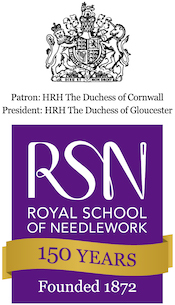The Royal School of Needlework is delighted to be part of a collaboration between the British Fashion Council and Google. Unveiled at The Fashion Awards 2016, the project is an exciting digital educational platform that brings to life the creativity, heritage and craftsmanship of British fashion.
The new platform g.co/britishfashion features content from fashion icons – brands, designers, makers and craftspeople, creatives, photographers, stylists and models – and uses technology to tell their stories. It is a single destination that educates and inspires future generations of young fashion creatives, designers and students.
Visitors can watch giants of the industry – from Burberry to Vivienne Westwood – in specially curated digital exhibits through innovative and immersive digital experiences. They will also be able to go behind-the-scenes of top craftspeople and producers of British fashion, including the Royal School of Needlework.
Click here to view the RSN’s exhibit.
There are over 1,000 assets to explore, including over twenty multimedia exhibits, twenty-five videos and three virtual reality experiences, all accessible from anywhere in the world, on desktop, laptop or mobile. Visitors can explore rich, archival materials from top British fashion houses, sorting their searches by colour and chronology. They will be able to get close to British Fashion’s biggest characters and moments, reliving Kate Moss’s first runway show at London Fashion Week and exploring profiles of the fashion industry’s key players – from Naomi Campbell to Christopher Bailey.
Dr Susan Kay-Williams, Chief Executive of the Royal School of Needlework said: “We are delighted to be part this unique project and to help educate and inspire audiences around the world. Traditional crafts such as the art of hand embroidery are part of our heritage and it is fantastic to see this tradition so current again in today’s fashion, whether on denim or silk. The RSN is the only place that teaches traditional hand embroidery skills to the highest level and we are very proud to be teaching these skills to future generations.”
Caroline Rush CBE, Chief Executive of the British Fashion Council said: “The internet has been an incredible resource for opening up the fashion industry to a new audience, giving young people access to information not previously available. This collaboration represents a new step, bringing together diverse information into one, engaging place. We hope this legacy project will not only inspire but also educate – allowing young people wanting to get into fashion to see the breadth of individuals, skills and careers that make up this multifaceted industry.”
Amit Sood, Director of Google’s Cultural Institute said: “British Fashion has such a unique and revered place within the international fashion industry, and is hugely rich in content, characters, icons and stories. It’s been a joy to work on this project and bring its distinct textures and tales to life through technology – so that now even more people around the world can enjoy it.”
Highlights of the digital collection also include:
• A super high resolution capture of a couture dress from Alexander McQueen’s SS17 collection, allowing people to zoom in and see its threadwork in never-before-seen detail; and a 360 video featuring the inspiration behind top couture dresses
• Manolo Blahnik at work in virtual-reality at his London atelier
• Curated exhibits from and about fashion legends and brands including Burberry, David Bailey, Edward Enninful, i-D magazine, J.W.Anderson, Michael Howells, Naomi Campbell, Paul Smith, Stella McCartney and Vivienne Westwood
• Decades of British craftsmanship from the houses of Harris Tweed, John Lobb shoes, Lochcarron Tartan and the Royal School of Needlework
The exhibition is available for free online and through the new Google Arts & Culture mobile app on iOS and Android. You can watch all the 360 degree videos on YouTube.
